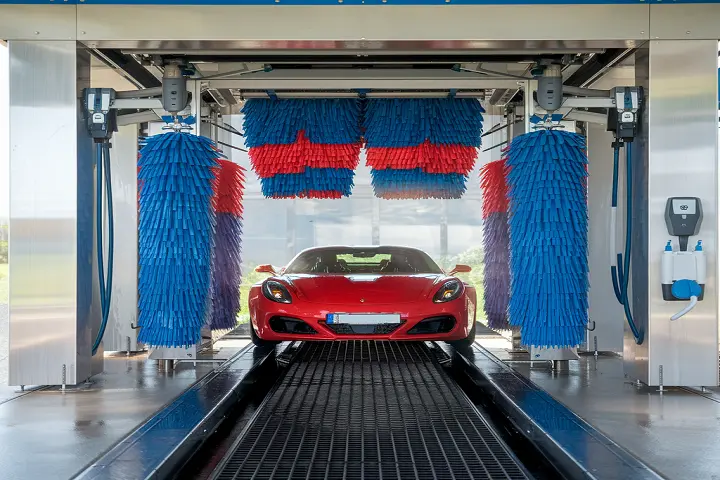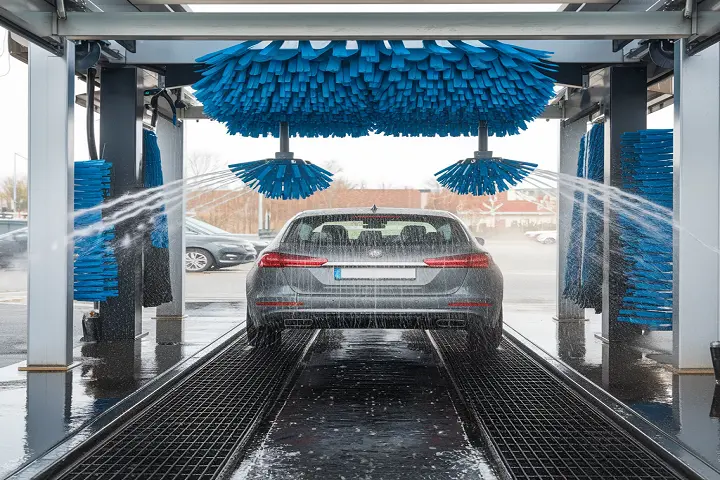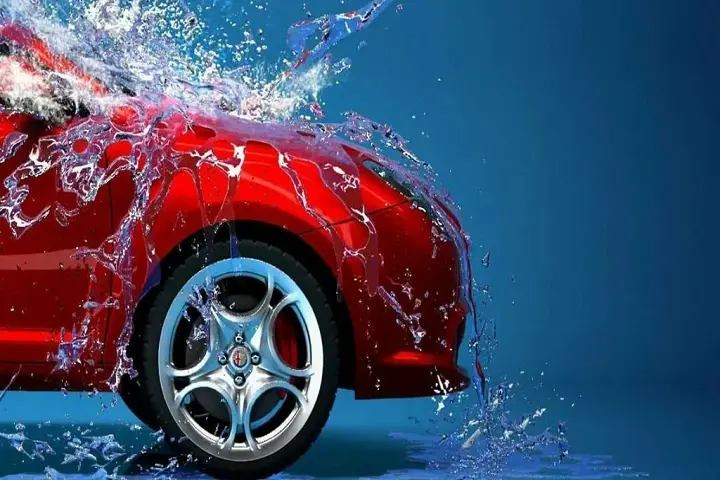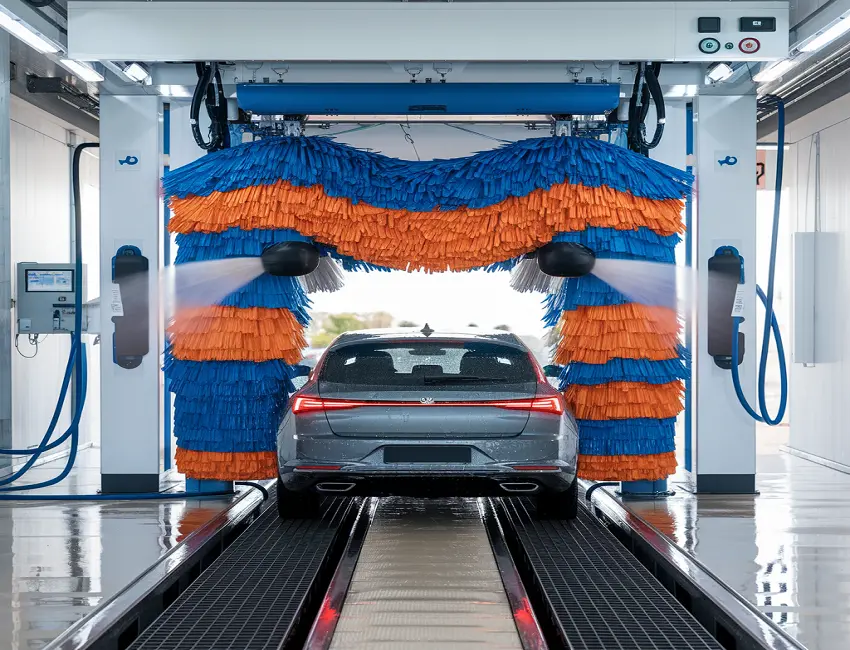In today’s fast-paced world, keeping your car clean isn’t just about aesthetics it’s about preserving your investment. Enter the touchless car wash, a modern marvel in vehicle maintenance that’s changing the game for car owners everywhere.
This comprehensive guide will dive deep into the world of touchless car washes, exploring their benefits, potential drawbacks, and how they stack up against traditional cleaning methods.
Whether you’re a car enthusiast or simply someone who wants to keep their ride looking sharp, this article will provide you with everything you need to know about this innovative car cleaning technology.
The Evolution of Car Washing: From Buckets to High-Tech Automation
Remember the days of spending your Sunday afternoon with a bucket, sponge, and garden hose? While there’s a certain nostalgia to hand-washing your car, the automotive care industry has come a long way. The journey from manual washing to automated systems has been driven by a desire for convenience, efficiency, and better protection for vehicle finishes.
Timeline of Car Washing Evolution:
- 1914 – First automated car wash opens in Detroit
- 1940s – Conveyor belt systems introduced
- 1960s – Brushes and cloth strips become standard
- 1980s – Soft-touch washes gain popularity
- 2000s – Touchless car wash technology emerges
This evolution has led us to the cutting-edge touchless car wash systems we see today, which offer a blend of thoroughness and gentleness that was previously unattainable.
The traditional car wash, with its whirling brushes and hanging cloth strips, has been a familiar sight for decades. However, as vehicle designs became more complex and paint finishes more delicate, the need for a gentler approach became apparent. This paved the way for the development of touchless systems, which promised to clean vehicles effectively without the risk of physical contact.
What Is a Touchless Car Wash?
A touchless car wash, also known as a “touch-free” or “no-touch” car wash, is an automated car cleaning system that uses high-pressure water jets and specialized cleaning agents to remove dirt and grime from a vehicle’s exterior without any physical contact. This method stands in stark contrast to traditional automated car washes that use brushes, cloths, or other physical cleaning implements.
Key Features of Touchless Car Washes:
- High-pressure water jets
- Advanced cleaning solutions
- Precision nozzle technology
- Automated drying systems
- Customizable wash options
The touchless approach aims to provide a thorough clean while minimizing the risk of scratches or damage to the vehicle’s paint and finish. This is particularly important for modern vehicles with complex paint systems, including clear coats and ceramic coatings, which can be sensitive to abrasion.
How Touchless Car Washes Differ from Traditional Automated Washes
While both touchless and traditional automated car washes aim to clean vehicles efficiently, their methods differ significantly:
- Cleaning Mechanism: Traditional washes use physical contact (brushes, cloths) while touchless relies solely on water pressure and chemicals.
- Risk of Scratches: Touchless washes virtually eliminate the risk of scratch marks from cleaning implements.
- Water Usage: Touchless systems typically use more water to compensate for the lack of physical scrubbing.
- Chemical Formulations: Touchless washes often employ stronger, more specialized cleaning agents.
- Cleaning Effectiveness: Traditional washes may be more effective on heavily soiled vehicles, while touchless excels at maintaining cleaner cars.
The Science Behind Touchless Car Washing

At the heart of touchless car wash technology lies a combination of physics and chemistry. Let’s break down the key components that make these systems so effective:
High-Pressure Water Jets
Touchless car washes utilize water pressurized to around 1,000 to 1,200 psi (pounds per square inch). This high pressure is crucial for dislodging dirt, bugs and other contaminants from the vehicle’s surface without physical contact. The force of the water creates a “scrubbing” effect that can remove most surface debris effectively.
| Pressure Level | Application |
| 1,000-1,200 psi | Typical touchless car wash |
| 2,000-3,000 psi | Professional pressure washers |
| 4,000+ psi | Industrial cleaning |
The precise control of water pressure is essential. Too little pressure won’t clean effectively, while too much could potentially damage vehicle surfaces or strip away protective coatings.
Advanced Cleaning Agents
The effectiveness of a touchless car wash heavily relies on its cleaning solutions. These specially formulated detergents and surfactants work to:
- Break down dirt and grime
- Emulsify oils and grease
- Lift contaminants from the vehicle’s surface
- Provide a protective layer post-wash
Many touchless car washes use a two-step chemical process:
- Pre-soak: Loosens dirt and softens contaminants
- Main wash: Lifts and removes loosened debris
The chemistry behind these cleaning agents is complex, involving a careful balance of pH levels, surfactants, and other additives. Some advanced formulas even incorporate nano-technology to provide additional protection to the vehicle’s surface.
Specialized Nozzle Technology
The design and placement of nozzles in a touchless car wash are critical. These nozzles are engineered to:
- Deliver water and cleaning agents at optimal angles
- Cover all areas of the vehicle, including hard-to-reach spots
- Adjust pressure based on different vehicle sections
- Minimize water usage while maximizing cleaning efficiency
“The precision of nozzle technology in touchless car washes is akin to a choreographed dance, ensuring every inch of the vehicle receives proper attention.” – Dr. Sarah Chen, Automotive Care Specialist
Advanced touchless systems may use oscillating nozzles or rotating arms to provide comprehensive coverage. Some high-end facilities even employ 3D scanning technology to map each vehicle and customize the wash process accordingly.
The Touchless Car Wash Experience
Walking you through the process, here’s what you can expect when you visit a touchless car wash:
- Entry and Selection: Drive up to the wash entrance and choose your wash package. Many modern facilities offer touchscreen interfaces or mobile apps for a seamless experience.
- Positioning: Align your vehicle on the conveyor or designated spot. Some systems use guide rails or lighted indicators to help you position your car correctly.
- Pre-Wash: A pre-soak solution is applied to loosen dirt and grime. This step is crucial for breaking down stubborn contaminants.
- High-Pressure Wash: Powerful jets spray water and cleaning agents across your vehicle. The precise choreography of these jets ensures comprehensive coverage.
- Rinse: Clean water rinses away soap and loosened debris. This step may involve multiple passes to ensure all cleaning agents are removed.
- Wax Application (optional): A spray wax may be applied for added protection. Some high-end packages might include ceramic spray coatings for enhanced durability.
- Drying: Powerful air blowers remove excess water. Some systems use heated air for more effective drying.
- Exit: Drive away in your freshly cleaned vehicle.
The entire process typically takes between 3 to 7 minutes, depending on the chosen package and facility. This efficiency is one of the key selling points of touchless car washes, making them an attractive option for busy individuals.
Case Study: The Impact of Touchless Car Washes on a Fleet Business
XYZ Delivery Services switched their fleet of 50 vehicles from traditional hand washing to a local touchless car wash facility. Over a six-month period, they observed:
- 30% reduction in time spent on vehicle cleaning
- 15% decrease in minor paint damage reports
- 10% improvement in fuel efficiency due to cleaner vehicles
- Positive feedback from drivers on vehicle appearance
This case study highlights the potential benefits of touchless car washes for businesses that rely heavily on their vehicle fleets.
Pros of Touchless Car Washes

Touchless car washes offer several advantages that have contributed to their growing popularity:
1. Scratch and Damage Prevention
Without physical contact, the risk of scratches from brushes or cloths is virtually eliminated. This is particularly beneficial for vehicles with delicate paint finishes or ceramic coatings. For car enthusiasts who invest heavily in their vehicle’s appearance, this peace of mind is invaluable.
2. Paint and Finish Protection
The gentle nature of touchless washes helps preserve your vehicle’s paint and clear coat, potentially extending the life of your car’s finish. This can contribute to better resale value and long-term appearance maintenance.
3. Speed and Convenience
With most washes completed in under 10 minutes, touchless car washes offer a quick and efficient cleaning solution for busy car owners. This time-saving aspect is particularly appealing in today’s fast-paced society.
4. Customizable Wash Options
Many touchless car washes offer various packages, allowing you to choose the level of cleaning and protection that best suits your needs and budget. From basic washes to premium packages with added waxes or sealants, there’s often an option for every preference.
5. Accessibility for Unique Vehicle Shapes
Touchless systems can effectively clean vehicles with irregular shapes or additional features like spoilers or wide mirrors, which might be challenging for traditional automated washes. This versatility makes touchless washes a good option for a wide range of vehicle types.
6. Reduced Risk of Mechanical Issues
Without physical brushes or cloths, there’s less chance of car parts like antennas, windshield wipers, or side mirrors getting caught or damaged during the wash process.
7. Environmentally Friendly Options
Many modern touchless car washes incorporate water recycling systems and biodegradable cleaning agents, making them a more eco-conscious choice compared to home washing or older car wash technologies.
Potential Drawbacks
While touchless car washes offer numerous benefits, it’s important to consider potential limitations:
1. Cleaning Effectiveness on Heavily Soiled Vehicles
For cars with caked-on mud or stubborn grime, the lack of physical scrubbing might result in less thorough cleaning in some areas. In these cases, a pre-wash or alternative cleaning method might be necessary.
2. Water Usage Concerns
Touchless car washes typically use more water than traditional automated washes, which can be a concern in drought-prone areas. However, many facilities are addressing this by implementing water recycling systems.
3. Chemical Runoff and Environmental Impact
The strong cleaning agents used in touchless washes may raise environmental concerns if not properly managed or recycled. It’s important for consumers to choose facilities that prioritize environmentally responsible practices.
4. Higher Cost Compared to Some Alternatives
Touchless car washes often come at a premium compared to traditional automated washes or self-serve options. This higher cost reflects the advanced technology and specialized cleaning agents used.
5. Potential for Water Spots
In areas with hard water, touchless washes may sometimes leave water spots if the drying process is not thorough. Some high-end facilities address this by using spot-free rinse water.
6. Less Effective on Certain Contaminants
While effective on most dirt and grime, touchless washes may struggle with certain contaminants like tree sap or industrial fallout, which might require more specialized cleaning methods.
Comparing Touchless to Other Wash Methods
To truly understand the value of touchless car washes, it’s helpful to compare them to other popular cleaning methods:
| Wash Method | Pros | Cons |
| Touchless Car Wash | – Minimizes scratch risk<br>- Quick and convenient<br>- Effective for light to moderate dirt | – May miss stubborn dirt<br>- Higher water usage<br>- More expensive |
| Traditional Automated Wash | – Lower cost<br>- Effective for heavy dirt<br>- Quick | – Risk of scratches<br>- Potential damage to accessories |
| Hand Washing | – Highly customizable<br>- Attention to detail | – Time-consuming<br>- Weather dependent<br>- Potential for improper technique |
| Waterless Car Wash | – Eco-friendly<br>- Can be done anywhere | – Limited effectiveness on heavy dirt<br>- Requires multiple microfiber towels |
Traditional Car Wash vs. Touchless Car Wash
While traditional car washes have been the go-to for many years, touchless systems offer some distinct advantages:
- Paint Protection: Touchless washes significantly reduce the risk of swirl marks and micro-scratches commonly associated with brush washes.
- Gentler on Accessories: Antennas, mirror caps, and other protruding parts are less likely to be damaged or dislodged.
- Customization: Many touchless systems offer more customizable wash options to suit different vehicle needs.
However, traditional washes may still have an edge when it comes to removing heavy soiling, as the physical scrubbing action can be more effective on stubborn dirt.
Hand Washing vs. Touchless Car Wash
Hand washing offers the most control and can be the gentlest method when done correctly. However, it comes with several drawbacks:
- Time: Hand washing is significantly more time-consuming than a touchless wash.
- Consistency: The quality of a hand wash can vary greatly depending on technique and products used.
- Water Usage: Home car washing often uses more water and can lead to runoff issues.
Touchless washes provide a happy medium, offering consistent results without the time investment of hand washing.
Maximizing Your Touchless Car Wash Results

To get the most out of your touchless car wash experience, consider these tips:
Pre-Wash Preparations
- Remove large debris by hand to prevent it from being ground into the paint during the wash
- Ensure all windows and doors are fully closed to prevent water intrusion
- Fold in side mirrors if possible to allow for better cleaning around these areas
- Consider a quick pre-rinse at home for extremely dirty vehicles
Choosing the Right Wash Package
- Assess your vehicle’s level of dirtiness and choose a package accordingly
- Consider add-ons like wax or underbody wash for extra protection, especially in harsh climates
- Look for packages that include spot-free rinse options if water spots are a concern in your area
Post-Wash Care Tips
- Dry any remaining water spots with a clean microfiber towel to prevent mineral deposits
- Apply a spray wax or quick detailer for added shine and protection
- Regularly inspect your vehicle’s finish and address any issues promptly
“Regular maintenance, including frequent washes, is key to preserving your vehicle’s value and appearance. A touchless car wash can be an excellent part of your care routine.” – Mike Johnson, Professional Detailer
The Future of Touchless Car Washing
The touchless car wash industry continues to evolve, with several exciting developments on the horizon:
AI and Machine Learning Integration
Future systems may use AI to:
- Detect vehicle type and adjust wash patterns accordingly
- Identify areas of heavy soiling for targeted cleaning
- Optimize water and chemical usage based on real-time data
- Predict maintenance needs and prevent system downtime
These advancements could lead to even more efficient and effective washing processes, further reducing resource consumption while improving cleaning results.
Water Recycling Systems
Advanced filtration and recycling technologies are being developed to address water usage concerns, making touchless washes more environmentally friendly. Some cutting-edge systems can recycle up to 90% of the water used, significantly reducing the environmental impact.
Eco-Friendly Cleaning Solutions
Research is ongoing to create biodegradable and pH-neutral cleaning agents that are effective yet minimize environmental impact. Some companies are exploring plant-based surfactants and enzymes that can break down dirt and grime without harsh chemicals.
Integration with Smart Car Technology
As vehicles become increasingly connected, we may see touchless car washes that can communicate directly with your car to:
- Automatically select the appropriate wash based on your car’s maintenance schedule
- Adjust settings for specific paint types or finishes
- Provide detailed reports on your car’s exterior condition
Enhanced Drying Technologies
New drying methods are being developed to improve efficiency and reduce the likelihood of water spots. These may include:
- Advanced air knife systems for more precise air flow
- Hydrophobic coatings applied during the wash to encourage water beading and runoff
- Infrared drying technology for gentle, even drying
Is a Touchless Car Wash Right for You?

Deciding whether a touchless car wash is the best choice for your vehicle depends on several factors:
- Vehicle Type: Ideal for cars with sensitive finishes or custom paint jobs
- Time Constraints: Perfect for those seeking a quick, convenient clean
- Environmental Concerns: Consider local water restrictions and recycling practices
- Budget: Weigh the cost against the benefits of paint protection and convenience
Vehicles That Benefit Most from Touchless Car Washes:
- Luxury cars with delicate finishes
- Vehicles with ceramic coatings or paint sealants
- Cars with custom paint jobs or wraps
- Newer vehicles you want to keep in pristine condition
Conclusion: Balancing Convenience, Care, and Conservation
Touchless car washes represent a significant leap forward in vehicle cleaning technology, offering a blend of convenience and care that appeals to many car owners.
While they may not be the perfect solution for every situation, their benefits in terms of paint protection and time-saving make them a valuable option in the world of car maintenance.
As the technology continues to advance, we can expect to see even more efficient and eco-friendly touchless car wash systems in the future. Whether you’re a car enthusiast looking to preserve your vehicle’s finish or a busy professional seeking a quick cleaning solution, touchless car washes offer a compelling option worth considering.
Remember, regardless of the washing method you choose, regular cleaning is key to maintaining your vehicle’s appearance and value. By understanding the pros and cons of touchless car washes, you can make an informed decision about the best way to keep your car looking its best for years to come.

With over 5 years of dedicated experience in the automotive industry, I am passionate about all things automotive. My journey began with a deep curiosity for automobiles, which led me to delve deeper into their mechanics, technology and trends. My expertise spans various aspects of the automotive world, from the latest electric vehicles to classic car restoration techniques. Through my articles, I aim to share my knowledge and insights, helping readers stay informed and inspired in the fast-paced world of the automobile.











